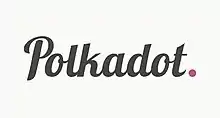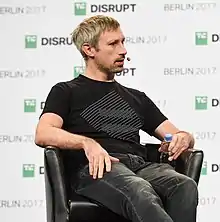Polkadot (cryptocurrency)
Polkadot is a heterogeneous multi-chain interchange and translation architecture which enables customised side-chains to connect with public blockchains.
 | |
| Original author(s) | Gavin Wood (Polkadot Paper) |
|---|---|
| Developer(s) | Parity Technologies, Chainsafe Systems, Soramitsu |
| Website | https://polkadot.network |
The protocol was created by the Ethereum co-founder Gavin Wood.[1]
History

Gavin Wood, Thiel Fellow Robert Habermeier and Peter Czaban are the co-founders of Polkadot. Gavin Wood was previously the Chief Technology Officer and is co-founder of the Ethereum Project.
While developing Ethereum and developing the new Ethereum 2.0 specification that would include sharding, Dr. Wood and his team began pondering the sharding hurdles a blockchain would face. From initial conception to a white paper, it took him about four months to come up with a vision for a heterogeneous multi-chain framework, the Polkadot Protocol. Wood released the Polkadot white paper[2] on November 14, 2016.
The technology surrounding Polkadot is set to help support the decentralization of the web, a concept pioneered by Dr. Wood and aptly coined ‘Web 3.0’. The subsequent innovations that followed Polkadot were Substrate, a framework to efficiently build your own blockchains; and the “canary” Kusama network that is independent of Polkadot but runs on early, unaudited versions of the same software as a proving ground for bleeding-edge technology.
References
- "The Hottest ICOs Are the Ones That Have Done the Least Amount of Work". Bloomberg Technology. Retrieved 19 December 2017.
- polkadot-white-paper: The technical vision paper for Polkadot, a heterogeneous extensible multi-chain, Web 3 Foundation, 2017-11-17, retrieved 2017-12-19
- "Polkadot passes the $140M mark for its fund-raise to link private and public blockchains". techcrunch.com. Retrieved 2018-01-17.